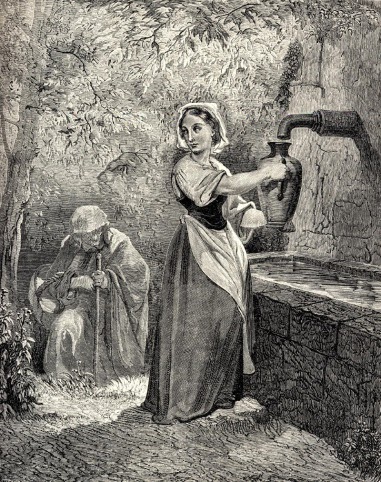THE TALE OF THE KIND AND THE UNKIND
GIRLS
An Overview of the Tale and its Many Versions
 |
| Gustave Dore's illustration for Perrault's "The Fairy" |
There
are many different titles for the versions of this tale, but the title “The Tale of the Kind and the Unkind
Girls” best describes the tale as a whole.
In the tale, specific character traits of the
heroine are tested including kindness, generosity,
obedience and politeness. The tale follows a characteristic plot line. A mother (or stepmother) mistreats her kind, often
beautiful, daughter and dotes upon her selfish, impolite, and usually ugly
daughter. The kind daughter is forced to
perform a task and, in the process, encounters
some sort of adversity, usually
at the hands of a supernatural being. The kind daughter responds with kindness
and obedience. Rewarded with a gift for
her good character, she returns home and sparks her mother’s jealousy. In order to acquire the same riches for her
own daughter, the mother sends her to meet the being. The girl is selfish and uncooperative and
instead of being rewarded, she is punished.
The bestower of the gifts hands out rewards and punishments fairly,
based on the the heroine’s inner qualities.
For the kind girl, the gift might be some type of physical
transformation such as jewels and flowers falling from her mouth when speaking
or a gold star planted on her forehead. The unkind girl is punished with a curse
that also represents her inner nature. She might receive a box full of bees or snakes. Or she
may also undergo a physical transformation such as toads and snakes falling
from her mouth when she speaks, a donkey tail planted firmly in the middle of her
forehead, or being dipped in pitch. The
rewards and punishments are always in clear opposition and mirror the opposing
character traits of the two girls. The tale ends with the kind girl enjoying
her rewards and the unkind girl being banished or dying. There are over one thousand
variations based upon this simple theme and the fairy tale is found in all
parts of the world. Individual storytellers alter the story to fit their
audience. Thus the story changes as it moves from culture to culture in order
to fit each new environment it encounters. For example, in one version recorded by the Grimms, when the kind girl shakes Mother Hulde's feather bed, it snows on earth. This version includes fanciful answer to the question "Why does it snow?" so this version would most likely not be told in an arid or subtropical climate that does not see snow. In the tropics, the girl might encounter a beneficent crocodile instead of Mother Hulde.
No comments:
Post a Comment